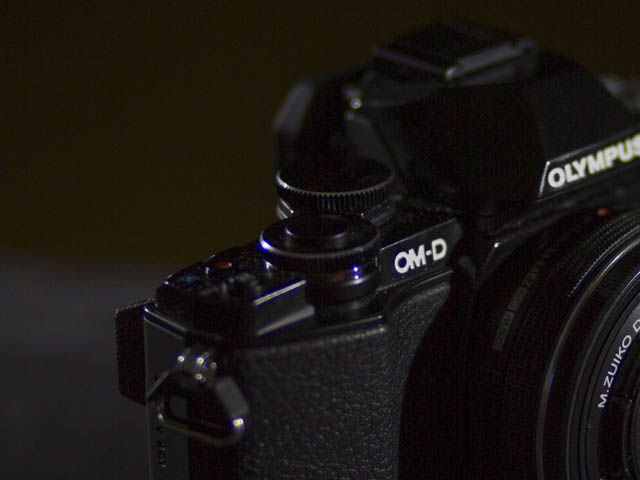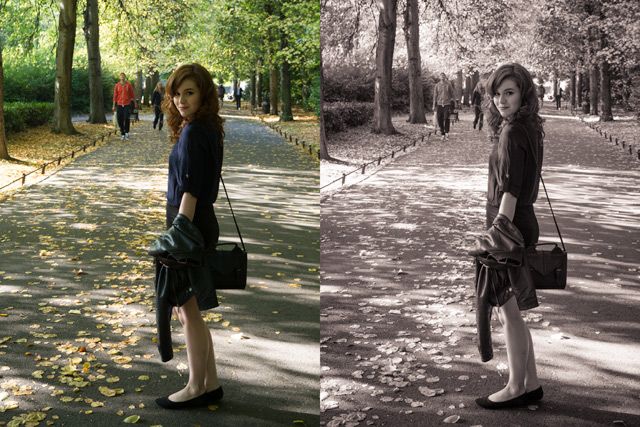Olympus OM-D E-M10
If you're looking for a mirrorless camera, you can't go wrong with the E-M10.
The $500 E-M10 is the entry level model in Olympus's respected OM-D range. It has a 16 megapixel Micro Four Thirds sensor that they claim can compete with the larger sensors found in entry level DSLRs. The model I reviewed came with the 14–42mm, f/3.5-5.6 Zuiko Power Zoom Pancake kit lens, available now from Amazon for $500.
Mirrorless cameras are becoming more popular as they close the gap in image quality and feature set with DSLRs. Their small size and light weight make them far easier to carry around. A good mirrorless camera, like the E-M10, will shoot RAW files, have full manual controls, and use interchangeable lenses — many of the things people have traditionally bought DSLRs for.
As one of the most popular cameras in the mirrorless field, we decided to take a look to see how the EM10 fared – and at the end of this review, we're giving it away to one lucky reader!
The Image Quality
First things first: if the images the E-M10 took weren't up to par, it wouldn't matter how great everything else about the camera was. Fortunately, the E-M10 takes great pictures with a 16 MP Micro Four Thirds sensor.
The RAW files have great dynamic range. I was able to recover a lot of highlight and shadow detail, even in poorly exposed files. If you nail the exposure in camera, you'll have a lot of data to work with in the post process. Straight out of camera, they looked a little flat to me but 30 seconds in Lightroom was enough to bring them to life. I also took the E-M10 along with me on a model shoot and edited the pictures fully–the results were great.
Compared to my old Canon 650D, the E-M10 stacks up well. My Canon cost more than twice as much three years ago and until recently was my primary camera. That the E-M10's images are of the same quality, is a ringing endorsement of what Olympus has put together.
In theory, the E-M10's smaller Micro Four Thirds sensor should have worse low light performance than the APS-C sensors in most entry level DSLRs. However, I found that even at relatively high working ISOs — 1000 to 1600 — the images never lost too much detail. Above 1600, there was some noticeable noise but that's to be expected. Perhaps you might get a little more useable ISO range with a camera that has a slightly bigger sensor but it shouldn't be a deciding factor.
Shooting with the E-M10
The E-M10 is pretty nice to shoot with. The main controls are great although things can be a little cramped.
My favourite thing about the E-M10 was the two control dials on top of the camera. If you shoot in manual mode, one is mapped to shutter speed and the other to exposure. If you shoot in a priority mode, one controls the priority setting while the other handles exposure compensation. This is a big deal – two dedicated exposure dials is a feature not found on many entry level DSLRs. Instead, they use a single dial and a modifier button. Having the main exposure controls readily to hand makes it easy to adjust settings on the fly.
Everything other than the exposure is controlled through the onscreen menu system. The 3 inch touch screen works, although hardware controls would be better (where you'd squeeze them on the tiny body, I'm not sure). The menu is fairly intuitive with important settings — such as ISO, and focus — accessible with one or two taps. It's not how I like to do things, but for anyone transitioning from a smartphone, it will all feel very familiar.
The E-M10 has a built in electronic viewfinder. It's better than using the screen on the back but not much more. The EVF screen is relatively low resolution so everything looks a little muddy. The quality of the images the Olympus actually took far exceeded what I was seeing through the viewfinder. It's perfectly adequate for framing shots but a definite step down from a mirrored viewfinder. Again, if you're transitioning from a smartphone this will be a step up but if you're used to DSLRs it will take some adjustment.
Autofocus with the E-M10 is really good. It's fast, accurate and, with the touch screen, you can choose pretty much any point on the sensor to focus with. I was never shooting with a very wide aperture so I can't say how it will handle focusing with very shallow depth of fields, but for almost everything above f/3.5 or so, it's never going to struggle.
The one issue I found shooting with the E-M10 was that the grip was tiny. I found I was holding the camera between my fingers rather than fully gripped in my hand. This meant accessing anything but the two main dials and shutter button required a bit of finger contortion. Olympus clearly prioritised keeping things small. Once you get used to it, the grip is fine but it is smaller than ideal. It's far from a deal breaker.
The Ecosystem
A camera is only one half of the equation. To take great pictures you need great lenses. The kit lens — which I'll cover in a moment — is decent, but if you're looking to shoot something more specialised like portraits, landscapes, wildlife, or sports, isn't up to scratch. Olympus has invested a lot in developing their Micro Four Thirds ecosystem and it's paid off well. There's plenty of great lenses available for the E-M10.
If you want to shoot sports or wildlife, you can get affordable telephoto lenses that have an equivalent focal length of 400mm. On the other hand, if portraits are your thing, the Zuiko 45mm f/1.8 with it's 90mm equivalent focal length is a decent counterpart to the 85mm lens I use on my full frame camera.
The bottom line is, if you buy the E-M10, you won't be stuck for good glass. Canon and Nikon with their decades of development may have more expansive ranges, but the Micro Four Thirds collection has something for almost everything.
The Kit Lens
The 14–42mm, f/3.5-f/5.6 Zuiko Power Zoom Pancake that comes with the E-M10 is surprisingly great. It has an equivalent range of around 28mm to 84mm which is perfect for a lot of situations. However, it's not the photos it takes that make it so good, but the size. When the camera is powered off, the kit lens sits close to the body maintaining the camera's low profile. Turn it on and the lens basically triples in size.
Most lenses this small have very limited focal ranges, that Olympus is able to squeeze such a decent walk-around zoom into such a tiny package is impressive. If you're buying a mirrorless camera, the odds are size and weight are major considerations and the kit lens fits the bill. I was impressed.
The Build Quality
It's built completely of metal so it has a nice heft to it without being too heavy. The entry level DSLRs it's competing with are overwhelmingly made of plastics so this is a big advantage. A metal body offers much better protection and durability. It's not weatherproofed, so taking it out in a thunderstorm is a bad idea, but I don't think you need to lock an E-M10 in a plastic bag at the first sign of rain. Similarly, don't play basketball with it, but it feels like it will handle a drop or two with only a few scuffs.
Everything else about the E-M10's build is to the same standard. The buttons and dials are all nice and tactile. The LCD screen is high quality. It's bright, the colors look accurate and the touch controls are responsive. It's no iPhone, but there's nothing to complain about. All in all, for a $500 camera, it's very well made.
The Extra Features
The E-M10 comes with a whole host of extra features that may, or may not, matter to you.
It has WiFi so you can connect to your smartphone and use it to trigger the camera. It works well though the use cases are limited.
The camera can record video though it's functionality is limited too. There' s no port for an external mic so sound quality is awful on the videos. There's not a lot of control over things like framerates and other things that matter if you're serious about shooting videos. If you want to record your kids' football game, it's fine, but otherwise it's more of a stills-only camera.
There are also built-in "Art Effects" which aren't terrible but certainly don't offer the kind of control over your images you get with a proper post processing workflow.
The EM–10 can shoot bracketed HDR images and combine them in camera. Again, this is something that works but isn't as good as blending them using Photoshop or another image editing app.
What's Not to Like?
There's very little not to like about the E-M10. Most of my issues — the small grip, EVF, and hit or miss extras — are flagged above and are relatively minor. They're certainly not reasons to avoid the camera. If you're looking at a mirrorless camera, you're going to have to get a small body, An EVF is a bonus on mirrorless cameras and far better than just using the back screen. Every camera comes with heaps of questionable "features" that do little more than fill out the spec sheet.
The only other gripe I had with the E-M10 was that something — and it's not the lens's focusing motor — makes a weird hum when you're using it. It's not so loud as to distract other people, but when you're holding the camera up to your face it can be irritating.
If I was to buy a mirrorless camera today I would give serious thought to the E-M10. I was pleasantly surprised at how good it was. It's no replacement for a professional DSLR, but it stacks up well against — and exceeds — most entry level DSLRs. It's hard not to like the size and weight savings of going with a mirrorless camera.
[recommend]If you're looking for a mirrorless camera, you can't go wrong with the E-M10.[/recommend]
Olympus OM-D EM-10 Mirrorless Camera Giveaway (Worth $499!)
Send your products to be reviewed. Contact James Bruce for further details.








